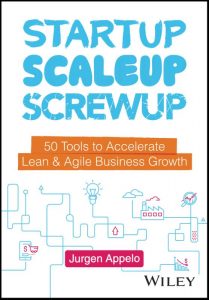Startups are fast learning laboratories where too many variables are at work in any given moment. The failure rate is high but success will be more favourable for those that use some systematic methods and processes along the way.
Serial entrepreneur Jurgen Appelo has put together a practical guide that gives you the latest tools and practical knowledge for a high growth venture. The book is packed with agile and lean community techniques and best practices.
You can build your business from an idea onwards by following the ten stages of growth. These stages are independent for each business model so in a larger company there can be more than just one business lifecycle simultaneously in different stages of maturity.
Initiation stage is the stating point where you have an idea that you develop further.
In Expedition stage you start to validate the hypothesis and formulate the business into an entity with bootstrap funding. Customer discovery and minimum viable product methods become relevant here in order to confirm a possible problem/solution fit.
Formation stage makes things official and it’s the time for a full time commitment for founders and initial team. Shareholder agreements, compensations and other growth structures become apparent. Vision/founder fit has been found and your team is ready to commit for the long journey.
Validation stage is the beginning for the product/market fit validation that usually takes minimum of three years. It’s the make it or break it for the next stages. Business model assumptions need to be validated and everything is geared towards proper traction.
Stabilation stage comes after the product/market fit issue has been somewhat solved. Scale too early and you may fail due to lack of traction. Scale too late and you may miss the market. Business/market fit becomes the focus and it’s more about the various business relationships around the product itself. Here the idea is fix things that did not scale before.
Acceleration stage defines your venture as a scaleup after the startup phase. Customer creation becomes the theme and it’s time to execute since things are working now after experimentation. Focus is on revenue and market share growth and trying to outsmart copycats and other competitors. As the organisation increases its size the complexity require more attention and different methods of management.
Crystallisation stage makes running the business more a “biz as usual” routine and it’s a sign of lifecycle maturity. This can take the form of an IPO or M&A trade sale for the founders.
Expansion stage is about trying to make most of the opportunity left and keeping the business model fresh with new initiatives and renewals.
Conservation stage is the cash cow moment where the end of the line is at sight.
Finish stage ends the business model and decisions need to be made about its existence.
The book is beefed up with interviews from various startup ecosystem players around the Northern Europe. These insights give a fresh and authentic touch for the multitude of ways to build and experience the startup growth.
Startup, Scaleup, Screwup is the best startup handbook I have seen for a long time.

